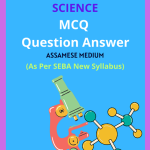Class 7 Science MCQ Chapter 9 Soil Solutions in English Medium, Class 7 Science Multiple Choice Question Answer in English to each chapter is provided in the list so that you can easily browse throughout different chapters Class 7 Science MCQ Chapter 9 Soil Notes and select need one.
Class 7 Science MCQ Chapter 9 Soil
Also, you can read the SCERT book online in these sections Class 7 Science Objective Type Solutions by Expert Teachers as per SCERT (CBSE) Book guidelines. These solutions are part of SCERT All Subject Solutions. Here we have given Assam Class 7 Science MCQs Solutions in English for All Subject, You can practice these here.
Soil
Chapter – 9
| MCQ |
1. The darkest layer of soil is:
(a) Top soil.
(b) Bedrock.
(c) C-horizon.
(d) Subsoil.
Ans: (a) Top soil.
2. In which of the following is humus present in a reasonable amount?
(a) A-horizon.
(b) B-horizon.
(c) C-horizon.
(d) Bedrock.
Ans: (a) A-horizon.
3. The water holding capacity is highest in:
(a) Sandy soil.
(b) Clayey soil.
(c) Loamy soil.
(d) Mixture of sandy and loamy soils.
Ans: (b) Clayey soil.
4. Which of the following present in soil has the smallest sized rock particles?
(a) Gravel.
(b) Silt.
(c) Clay.
(d) Sand.
Ans: (c) Clay.
5. Which type of soil is suitable for growing wheat, gram, and paddy?
(a) Sandy soil.
(b) Clayey soil.
(c) Loamy soil.
(d) Peaty soil.
Ans: (b) Clayey soil and loamy soil.
6. What are the different types of soil mentioned?
(a) Sandy, peaty, silty.
(b) Clayey, loamy, sandy.
(c) Loamy, silty, chalky.
(d) Clayey, sandy, chalky.
Ans: (b) Clayey, loamy, sandy.
7. Which one of the following cannot be an effect of soil erosion?
(a) Desertification.
(b) Desalinisation.
(c) Flooding.
(d) Famine.
Ans: (b) Desalinisation.
8. Which of the following cannot prevent soil erosion?
(a) Reforestation.
(b) Deforestation.
(c) Silviculture.
(d) Plantation.
Ans: (b) Deforestation.
9. Which type of soil can lead to the maximum water logging in the fields?
(a) Loamy soil.
(b) Clayey soil.
(c) Sandy soil.
(d) Sandy-loam soil.
Ans: (b) Clayey soil.
10. One of the following is not a type of soil. This one is:
(a) Loamy soil.
(b) Silty soil.
(c) Clayey soil.
(d) Sandy soil.
Ans: (b) Silty soil.
11. In which horizon of soil minerals are found?
(a) A.
(b) B.
(c) C.
(d) E.
Ans: (b) B.
12. What is a soil profile?
(a) The type of soil.
(b) A section through different layers of soil.
(c) The top layer of soil.
(d) All of the above.
Ans: (b) A section through different layers of soil.
13. Which type of soil has the highest percolation rate of water?
(a) Clayey soil.
(b) Loamy soil.
(c) Sandy soil.
(d) None of the above.
Ans: (c) Sandy soil.
14. Which of the following crops is best suited for sandy loam soil?
(a) Wheat.
(b) Cotton.
(c) Paddy.
(d) Gram.
Ans: (b) Cotton.
15. Soil conservation measures are mainly aimed at protecting which of the following?
(a) Plants.
(b) Topsoil.
(c) Subsoil.
(d) All of the above.
Ans: (b) Topsoil.

Hi! my Name is Parimal Roy. I have completed my Bachelor’s degree in Philosophy (B.A.) from Silapathar General College. Currently, I am working as an HR Manager at Dev Library. It is a website that provides study materials for students from Class 3 to 12, including SCERT and NCERT notes. It also offers resources for BA, B.Com, B.Sc, and Computer Science, along with postgraduate notes. Besides study materials, the website has novels, eBooks, health and finance articles, biographies, quotes, and more.



